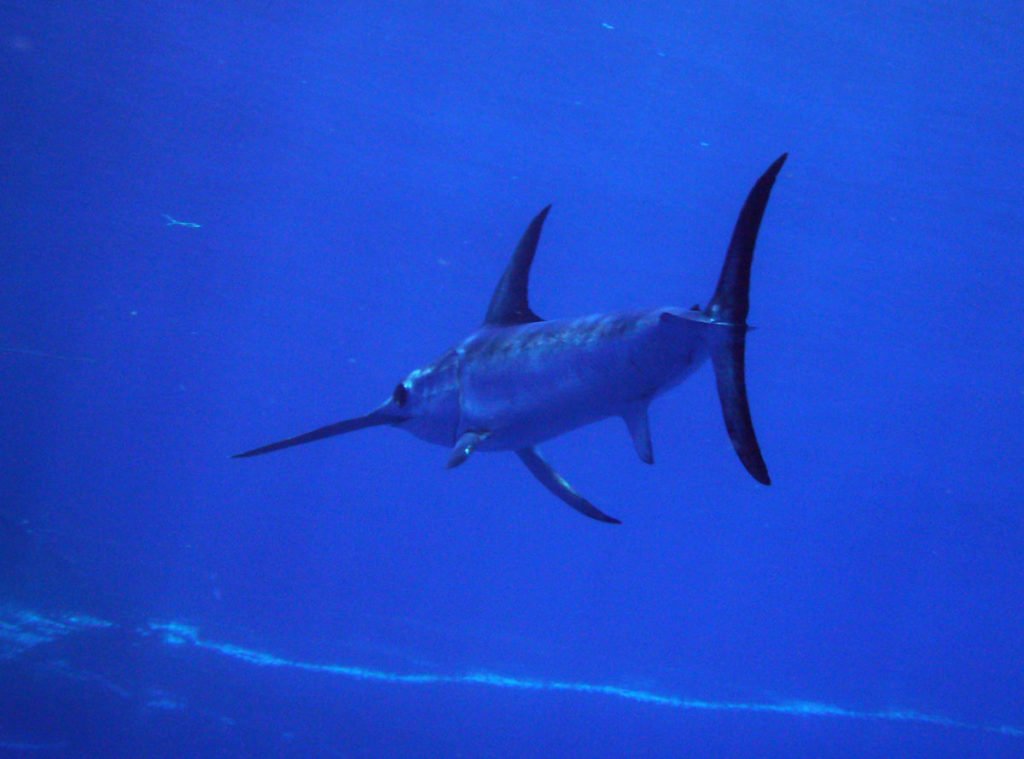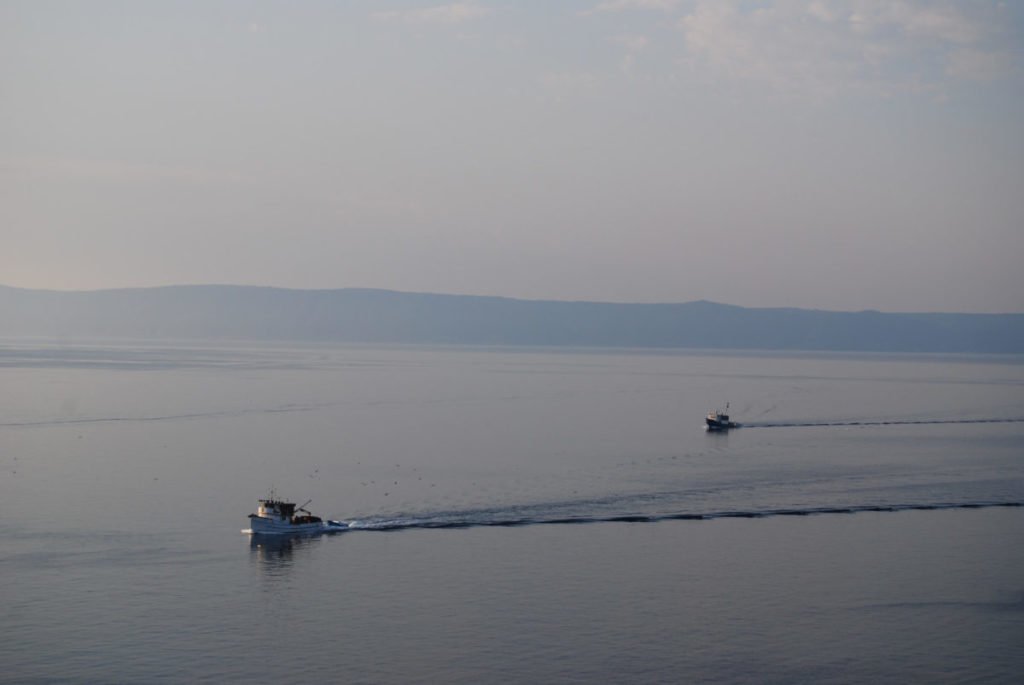
It is well into night, and she moves slowly. Her sword pierces the water that slides away like sheets of ice. Bubbles spin into small vortices that carry her forward. She pushes the water, and the water pushes back.
The long barrel of her body arcs from side to side as she swims, propelled by her tail fin, scalloped and black, sharp as a sickle. Water, eye, and brain, are all one. Her looking links intention to muscle.
Specks of life—the tiny jellies, the embryonic fish and crabs and eyeless shrimp—crowd together into the layer of water hovering one hundred feet below the surface. What little light there is tugs at everything. The layer floats up at night, by day it settles back down, cooling as it descends. Swirls of life pitch and roll through porous bodies. The jellies spark, then dim, then light up again. Fish drag long contrails as though unwilling to part with the water.
It is as noisy as the world of the embryo, clicking, strumming, a distant pluck here, now down there, and there, and there. The groans of the whales from far off. The waves loud and frothy at the surface. The artless, mechanical churning of a distant engine.
She approaches the mackerel, all turning together in their signature school, making currents that register along the lateral line of her flank as she closes in. She accelerates abruptly, faster than the school can move away. As if anticipating response, she turns slightly and divides the school into two neat bodies, each moving separately and apart. She turns back, ripping the water from the fish with the slash of her bill. Stunned, a lone mackerel drifts down and away. She is upon it, mouth open. It slides down her gullet as she turns to slice and slash again, and again, until the school spins away on this tiny tide of killing.
She slows, but never sleeps. Her big eyes gather the light, warmed by a filigree of tiny blood vessels draped between her brain and eye. Because of this, she can dive deep into the cold water that snugs the bottom, chasing squid or evading her only enemies—the orca and the big sharks.
Like everything else in that band of ocean that is neither surface nor bottom, she lives by the light and dark cycles that ebb and flow with the sun and moon. And the slower cycle of the earth’s turn that pulls the hot current from Florida up along the Atlantic to the cold canyons of the north where her food may be. As the days get shorter, she heads across the ocean following the current, to the Azores, and Spain. Or south to the Caribbean, the Florida Keys, the Gulf of Mexico, where cloudy water spills from the big river that tastes of fields and trees.
She is eight years old and twelve feet long from tip of her sword to the notch of her tail fin. She’ll weigh in at over four hundred pounds if she’s ever hooked. Last year, she spawned three million eggs in the southern waters, but now in November, off the Massachusetts coast, her belly is flat.
What she wants, and what she knows, and what she does are pure instinct.
***
It is my third trip on the swordfish boat. We’re all on deck—Bruce, Tim, me—getting ready to string the longline out into the water for the night into a patch of water that might be appealing to swordfish. Michael, our captain, steers from the wheelhouse, looking for the edge. Chances are it’s near the one hundred-fathom curve, that light blue contour line on the chart where the cold water from shallow continental shelf spills into the ragged canyons that have snagged warm Gulf Stream water.
He watches the needle on the temperature gauge that’s wired to a sensor six feet below the waterline, waiting for a shift of a few degrees up or down. He checks our position on the chart, compares it to the mark he made this morning when we hauled that big sword up from the deep. He estimates the drift, how the gear might float pulled by currents below, pushed by wind and waves above.
The wind is cool coming off the ocean swell. Northwest, ten knots, increasing to twenty overnight, the NOAA weatherman says. Steady at twenty through tomorrow afternoon. We’ll set downwind so that, with luck, hauling back in the morning we’ll be headed upwind.
Tim and I at the rail, each with our own bucket of branch lines and each within an arm’s reach of a tub of thawing mackerel. My job is pretty simple, and I have more or less mastered it: bait hook, toss branch line, clip to mainline. Repeat. I’m glad for the repetition. The last three days have been hard—big seas, lots of fish, long days on deck. The thought of wedging myself into my bunk for the night keeps me going.
Bruce stands in the middle of the deck facing forward, balancing the long staff buoy horizontally like a weight lifter poised for the press. One end has weights that will hold the buoy upright in the water. The other end has a radar reflector and a white strobe light. The staff buoy is already clipped to the end of the mainline. Once Bruce hurls the buoy overboard, its weight will drag the mainline off the boat as we motor away from it.
Lights atop the wheelhouse illuminate the deck and spill out over a dark froth of waves and the white gulls hovering over them. When the boat rolls, the water is so close I can touch it.
Michael leans out the wheelhouse door and latches it open, so he can get onto the deck quickly if need be. He reaches up and pulls the lever that sounds the horn into the rising wind. We start setting the gear.
***
Her eyes harvest what little light there is. She is alert for the places where water curdles in the wake of a mako or other big sharks—the tiger and the white—that may be drawn by the smell. Turning on her side, she slides by the blot of blood. She is as fast as any fish in the ocean, but she is sated for the time being, her hunting juices absorbed by muscle. The water near the surface is filling with moonlight, pulling the band of life closer to the surface. She follows her bill upward, drawn by the life that is drawn by the light.
***
The longline streams past me pulled by the weight of the gear already in the water. I cup the next mackerel in my left hand as though it could escape my grip. With my right hand, I plunge the four-inch stainless hook into the cold flesh, down one side of the dorsal fin, up again so that the barb is fully hidden in its belly. I toss the baited hook underhand away from the boat, and the branch line uncoils from the bucket through my open hands. I catch the clip just before it too goes overboard and pull the clip against the taut pressure of the streaming line, fixing it to the mainline that is unspooling into the dark behind the boat at the same five knots we are moving forward.
I reach for another mackerel, another hook. “Eight,” I call into the wind, announcing the step of the dance for the others on deck. My hands are aching, but I’ve worked through the stiffness and no longer feel the sting of salt from my soggy gloves. I lean against the rounded rail that molds the soft, sore flesh of my hip.
“Nine!” Tim calls out as he clips on the next branch line.
I wait a beat, then fling my next branch line out and away. “Ten,” I yell as I clip it on.
Bruce waits the same beat, then tosses an orange float over the side, its coil of line unfurling as he clips it onto the mainline. “Float!” he yells above the drone of the engine, the whine of wind in the rigging.
We do this over and over again. Ten branch lines. Then a float, followed by ten more branch lines, then another float. Sixty feet between hooks, six hundred feet between floats. A staff buoy every mile, its radar reflector and strobe signaling to any passing ship that there is fishing gear in the water.
We brace our bodies against the rail to work with two hands, legs wide, knees bending to the roll of the boat. We are the link between the boat and gear for three hours until the last lighted buoy goes over the side.
When we’re done, we have 1,500 hooks in the water strung along a mainline that stretches twelve miles, hanging in a catenary from the surface, like a drooping telephone cable. The gear is all of a piece now, finding its depth between the buoys riding the waves above. The branch lines hang even further down from the mainline, floating and fishing at sixty feet or more below the surface.
Michael turns the boat into the wind, slows the engine and waits for the bow to fall off the waves and the boat to settle into its drift before turning off the engine.
We wash the slime and scales from the buckets, stack them up forward and tie them down. Tie everything down. You never know what will happen during the night.
Bruce faces the wheelhouse and raises one thumb up. “All set, Cap.”
Michael turns the deck lights off. The masthead lights aloft dimly outline the edge between our world on the boat and everything else. Out there, the birds that have followed us for miles, settle on the waves, still hopeful for a bit of bait. From time to time, a wave thuds against the hull.
We all settle in for the night, as the moon pulls its weight from the ocean to the stars.
***
No longer linked to the boat, the gear drifts through the ocean and through the night. Currents pull the line one way, while the wind pushes the buoys on the surface, sometimes the same direction, sometimes not. Each branch line dangles from the mainline with its hook hidden in the soft belly of a mackerel that is along for the ride.
The moon rises, the light penetrates deeper into the water. The scattering layer, that band of life in the water, rises. The mackerel and squid follow. And with them, the sharks, the tuna, the swordfish. Everyone is eating someone.
***
From the corner of her eye she sees the schooling fish, their bodies striped silver and blue, shining one way, then the next, moving as one for safety. She charges into the school, slowed only by her bill slashing through the slippery water. As the school disperses, she turns and circles open mouth gulping halves of fish that have been sliced in two. One last fish remains. With two powerful beats of her tail, she closes in, mouth open. The fish slides partway down her gullet as she moves on.
A sharp sting. Her heart pumps faster, she accelerates forward. The sharpness digs deeper into the roof of her mouth. She twists to change course, a reflex designed to avert danger, and feels pressure from the thin branch line in the crease between her gill cover and bony collarbone. The water thickens as she pulls against the weight of mainline and floats.
She thrusts her powerful tail to push, up, up, up, then free of water into the black moonlight. She falls back down away from the light driven by pure adrenaline. Dives, rises, swims until she can pull no longer. Rest. Swim. Rest. Fatigue overtakes fear. Water passing more slowly over her gills, delivering less oxygen to fuel her fight.
The small fish and squid are settling deeper as the rising sun chases the moon over horizon. She would swim down if she could.
Later, somewhere beyond her brain there is the graceless thudding of a propeller, a noise she has avoided her whole life. She is pulled through the water towards the sound, the drag on her body equal to what little she has left to fight with.
***
On the rim of dawn, the pattern of waves rise like distant peaks as dark becomes gray and gray becomes blue. We’ve been hauling back for an hour now and the deck lights are no longer needed.
“Swordfish!” Tim calls out. I look up and see the dark sword knifing towards the sky, followed by the dorsal fin, the body flattening on the water as though preparing to dive. Michael slows the engine. Tim slows the line hauler. Bruce leans across the deck with the twelve-foot wooden gaff.
“Hold up, Tim!”
The mainline angles into the water where the branch line is clipped. Both are taught with the weight of the fish. She is just beyond the reach of Bruce’s gaff.
“Slowly,” Michael says, tight like he’s talking to a caged animal.
Bruce lunges, sinks the hook of the gaff into the eye socket and pulls the fish toward the boat. Michael lunges with a shorter gaff, sinks it in the same eye. The fish is now close to the rail, floating, her tail barely moving. The streak of midnight purple that flanks her dorsal fin is turning slate-colored by the second.
“I think we’ve got a marker!” someone yells. This fish will fetch a better price per pound.

“Get a hand hook into her.” You just never know when the hook that caught the fish, that one down the gullet might pop free.
The long gaff changes hands. Someone swings an eighteen-inch iron into the fish’s mouth seeking the hard underside of the skull.
“OK. I got her. Get a strap on her.”
It is almost certain the fish is now ours, but no one is taking any chances. Michael’s at the winch, lifting the fish high enough that its body clears the rail. Bruce pushes the tail toward the other side of the boat as Michael lets slowly off on the winch, and the fish is aboard. It must be twelve feet from tip to tail, with a belly wider than my waist. The gills arc slowly in and out as though pulling the last bit of oxygen from the foreign air.
It’s the first fish of the morning. There may be more. We all turn back to our respective jobs, buoyed by our good fortune.
I know that he next time I look back, Bruce will have sawed off the bill and sliced off the tail fin. Blood will be streaking the deck.
Already it smells of death and money.

Share this post with your friends.


Riveting story, felt like the swordfish. Definitely, gave one the feeling of being on the boat and setting the lines. Loved it!
Thanks, Joan, I’m glad this helped you get out on the ocean again!
This pescatarian may be questioning her ways. Lots of empathy for that big fish! I felt a visceral connection to the fisherman and the fish!
I’m amazed at the author’s ability to so vividly convey the underwater experience of the swordfish!
Yes, it’s been hard for me to eat swordfish since those days. And these days, hard to any any fish, though lobsters — mostly holding their own from fishing pressure in New England at least — still call to me. Thanks for reading!